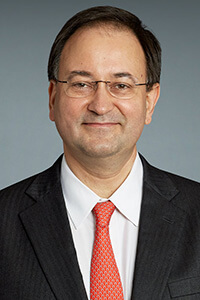Team Assesses Safety of t-PBM, Non-Invasive Brain Stimulation Technology That Uses Light to Treat Depression and Anxiety
Team Assesses Safety of t-PBM, Non-Invasive Brain Stimulation Technology That Uses Light to Treat Depression and Anxiety

The last decade has seen a vast increase in the use of brain stimulation technologies to reduce symptoms of psychiatric illness. By far the most influential has been TMS, a non-invasive method employing magnets that generate electric fields which are thought to therapeutically alter the activity of neurons and brain circuits involved in depression and other disorders.
TMS was pioneered by BBRF Scientific Council member Mark S. George, M.D., who used two early-career BBRF grants to develop the protocol ultimately approved by the FDA in 2009 for the use of TMS in people with treatment-resistant depression. Use of TMS has expanded greatly since then, along with the development of rTMS (in which the magnetic pulses are short and repetitive), and iTBS (in which the duration of treatment sessions is greatly reduced). TMS and its variants are now FDA-approved for use in depression of all kinds as well as OCD and smoking cessation. Trials are being conducted in other disorders, including PTSD and suicidality, while other trials are testing it in already approved indications using higher powered or individually targeted versions of the technology.
Research continues, meanwhile, on a variety of other invasive and non-invasive methods of therapeutically stimulating brain cells. One that has been in development for the last decade but has not yet received FDA approval is called t-PBM (transcranial photobiomodulation). Like TMS, t-PBM is non-invasive. In t-PBM, a cap, helmet, or open-framed device is worn by the patient, which delivers light waves generated by either lasers or LEDs (light-emitting diodes). The key is that the light delivered be of a particular wavelength, ranging from deep red to near-infrared (wavelengths of about 600 to 1070 nanometers). Such light can penetrate the skull and alter the biomechanics of underlying tissue and cells.
Paolo Cassano, M.D., Ph.D., of Massachusetts General Hospital, is an innovator of t-PBM, including that delivered in the near-infrared band of the spectrum. Such light is called NIR light, for near-infrared. Dr. Cassano’s 2012 BBRF Young Investigator project enabled him to experiment with NIR t-PBM. In 2015, he led a pilot randomized, controlled clinical trial using this technology to treat 4 patients with major depressive disorder. In 2018, he led a team in a randomized, controlled trial of t-PBM using LED technology. Both trials saw reductions in depression symptoms, encouraging further testing of t-PBM.
Now Dr. Cassano has joined in a new paper with colleagues including t-PBM pioneer and 2006 and 2001 BBRF Young Investigator Dan Iosifescu, M.D., Ph.D., of the Icahn School of Medicine at Mount Sinai. In a 2019 review paper, Dr. Iosifescu and a colleague noted “strong evidence for the mechanism of t-PBM,” specifically its apparent ability to increase mitochondrial energy production in brain cells, and to increase regional blood flow. The downstream effects of increased ATP production in mitochondria, he noted “include not only increased cellular energy but also, potentially, increases in intercellular signaling.”
In their new paper in the journal Photonics, Drs. Cassano, Iosifescu and colleagues call t-PBM with near-infrared light “a promising treatment option for mood and anxiety disorders, due to its low cost and ease of self-administration.” The latter includes the possibility of developing t-PBM devices which can enable patients to self-administer treatments at home. This would make the technology widely accessible.
One thing still missing which may in part prevent t-PBM from getting FDA approval is the paucity of research rigorously testing the safety profile of t-PBM. In their new paper, the team sought to evaluate the tolerability and safety of t-PBM for treatment of major depressive disorder (MDD) as well as generalized anxiety disorder (GAD).
They conducted a systematic analysis of side effects from repeated sessions of t-PBM, as employed in three clinical studies. One was an open-label (i.e., unblinded) study using NIR t-PBM in patients with GAD; two were randomized control studies for patients with MDD. Dr. Cassano was involved in all three trials, which, overall, involved the treatment of 80 individuals.
Results of the analysis showed that a low dose of NIR in each t-PBM session “can be administered with increasing frequency (up to daily sessions) and for a period of several weeks (up to 12 weeks) without a corresponding increase in the occurrence or severity of adverse events.” The analysis also turned up no significant factor—for example, age, sex or diagnosis—that served to predict which patients would have side effects or what kind of side effects. The most common side effects are headaches, perception of vivid colors, and irritability. Other reported effects in trials involving other illnesses include strange tastes in the mouth, unusual sensations, and dizziness.
To date, the team reported, “the literature indicates that higher dosages of transcranial NIR could lead to greater antidepressant and anxiolytic [anti-anxiety] effects.” But their study “did not find any correlation between the increasing number of t-PBM sessions and the occurrence of adverse events.”
Due to its low cost, benign safety profile in trials so far conducted, and ease of self-administration, “t-PBM has the potential to become widely accessible,” the team wrote. “However, despite its clear advantages no consensus exists on the optimal parameters of t-PBM.” A consensus on parameters such as location of where on the scalp t-PBM is administered, at what wavelength for particular disorders, and at what intensity, all will likely have to be arrived at before t-PBM can gain FDA approval.
In addition, the team notes, large clinical trials for t-PBM in depression and anxiety have not yet been conducted. While safety results in the three studies in these illnesses they reviewed were good, the sample of tested patients is much too small to consider the results definitive.




